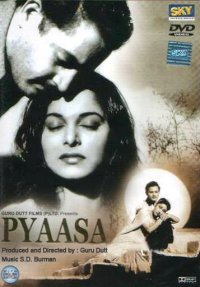
 …how many directors are there in the world who have achieved immortality through cinema?’ The question raised above is not just an extract from writer Nasreen Munni Kabir’s introduction of the book ‘The Dialogue of Pyaasa’ but also a one line summary of the intent behind Guru Dutt’s classic Pyaasa being converted into a book.
…how many directors are there in the world who have achieved immortality through cinema?’ The question raised above is not just an extract from writer Nasreen Munni Kabir’s introduction of the book ‘The Dialogue of Pyaasa’ but also a one line summary of the intent behind Guru Dutt’s classic Pyaasa being converted into a book.Responsible for the concept, introduction, translation and commentary, Kabir continues the good job after her similar efforts for the dialogues of Mughal-E-Azam, Awaara and Mother India. One has to compliment her for the choice of her films as each of the aforementioned classics are not just rich in overall cinematic appeal but also boast of some of the most powerful/high impact dialogues that the era gone by has evidenced. This is why the effort of Suhail Akhtar (who transcribes the original dialogue in Urdu and Roman) and Vijay Jani (who does the same in Hindi) needs to be lauded. They ensure that the job is done right while also maintaining the entire readability aspect that would make turning over the pages an exciting affair. Boasting of a brilliant layout, both from the design as well as content placement perspective, ‘The Dialogue of Pyaasa’ is the kind of study which makes for a very good read, especially if you are one of those select few people who have not seen the film yet. The best part about the book is that it doesn’t restrict itself to a language. Since it’s a Hindi film, it is but natural that the dialogues appear in Hindi. However, for the benefit of a wide segment of readers at which the book is targeted, the dialogues appear in Roman as well as Hindi script. This is not all as the dialogues are also transcribed in Urdu and Roman, hence making it a four-in-one package. So here is the deal – If you want to read and visualise the scene in an ‘as-is’ manner, there is a Hindi version for you. If you find reading a Hindi script in English more interesting, there is an alternate available. And then if English and Urdu come naturally to you then there is also some good transcription done in both the languages which makes it a complete affair.
This is where the design comes in handy because all the four options are made available on the two pages open in front of you, hence saving you from the effort of traversing between different sections of the book. Also impressive is the way dozens of screen shots from the film are brought to life all over again in the book. Since the book moves reel by reel and then scene by scene, placement of screen shots at the top of the page gives an extra edge to the narrative. This is not all as towards the end of the book, Kabir goes on to take the reader through every reel of the film (in total 16) and shares various anecdotes and facts about the happenings both in front of and behind the camera. However those who have already been familiar with Guru Dutt’s work via a couple of books about him which have been released in last few years, there isn’t much to dig upon as most of the interesting anecdotes have already been covered in the past. Nevertheless, if you are the kind who loves to revisit the past and unearth the heritage left behind by some of the legendary film makers of the past, ‘The Dialogue of Pyaasa’ is a journey worth taking. Especially so because original dialogues by Abrar Alvi and lyrics/poetry by Sahir Ludhianvi is pretty much the kind of literature that is seldom practiced today. Well, in the world of movies at the least. Also, the book turns out to be a quick reference for those who pride on being the know-how of the world that has gone past by or wish to taken centre stage when challenged to narrate a line or two from yesteryear classics. Having said that the fact remains that audience is quite niche for an effort like this. Though the product price has been considerably reduced here (with an added incentive of the film’s DVD being included as well), it requires an audience which has a bent of mind to actually turn over those 200 odd pages and go through every dialogue. With the entire literature available visually (via DVD), a majority would instead choose to play that on instead of spending a couple of hours going through the reading material. However for those who don’t quite mind that and instead choose to preserve and cherish such heritage in a book format, ‘The Dialogue of Pyaasa’ is indeed a collector’s delight. There is a trend building up to bring to fore the dialogues of some of the classics that enthralled the audience years back. Thankfully.
And one is mighty pleased with the idea because in the times when one of forever connected to the entire world with mobile internet, it is nothing short of an achievement for a team to actually come together and put together a book which aims at preserving a classic in a shape which could appeal to today’s youth.

Be the first to comment